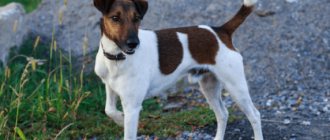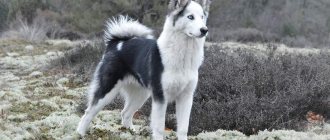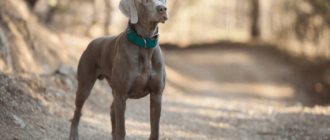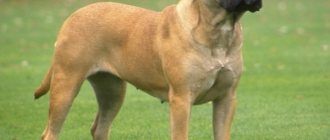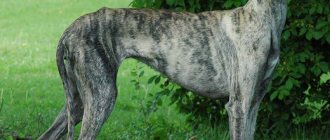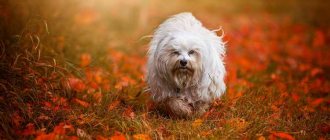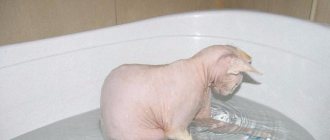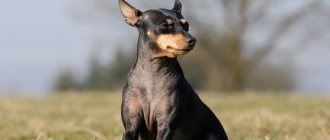Description of the history of the breed
This breed is one of those few, the creation and modification of which were carried out by the best biologists and breeders. This unusually strong and fast breed was bred specifically by order of government authorities. And while the history of other breeds is shrouded in mystery, the pedigree of Muscovites is open and transparent, and the fact that they were born for a special mission only adds prestige and charm to the breed.
After a war that not only claimed thousands of lives, but also left many dogs homeless and shelters destroyed. The workers of the Krasnaya Zvezda kennel, which was located in the Moscow region, were tasked with raising dog breeding from its knees. The letter that came “from above” clearly stated: “ To breed a breed for protection that would correspond to a high class of speed, endurance, physical strength and is easy to train .”
The basic breeding “ingredients” of the work were the St. Bernard and the Caucasian Shepherd - these two breeds, absolutely polar in character, gave birth to such an unusual combination. Also involved in the process:
- German Shepherd;
- Newfoundland;
- Russian greyhound;
- Russian piebald;
- Russian hound.
This was a very difficult job, because it is always more difficult to correct the results of multi-species crossing, but Russian cynologists coped with the task perfectly.
Not only the best and healthiest representatives of the breed were chosen for crossing, but also those who distinguished themselves during military operations and hostilities. The entire procedure was carried out in the fifties of the twentieth century. The entire process was supervised by A.P. Mazower, owner of the shelter. The firstborns of the breed were shown at an exhibition in Moscow, but at that time they were still listed in the documents as a “crossbreed”.
Subsequently, the breed was modified, and all changes were documented. The parents of purebred Moscow watchdogs were Ashi (Caucasian Shepherd) and Barry (St. Bernard). The government's order was carried out. The standards and basic traits of the breed were documented in 1958, although they have changed several times since then.
All subsequent work on breeding dogs and maintaining the breed population was carried out by amateurs on a voluntary basis. Most amateur dog breeders note that the breed has changed for the worse. Absolutely all breeds go through this process on their way to the ideal.
History of the origin of the breed
After the end of World War II, Soviet nurseries were faced with the need to solve the problem of a shortage of animals. And it was precisely this circumstance that prompted the Red Star specialists to create a request for the breeding of a new breed of dog that would be able to serve even in the most difficult conditions, be unpretentious, easily and quickly learn and obey a person. And at the same time, she combined a set of qualities of a guard dog and a protector dog. The conditions under which the breeders worked were harsh: the breeding base consisted mainly of trophy animals exported from Germany. The project manager was A.P. Mazower. However, through their efforts, four breeds were bred at once. One of them turned out to be the Moscow guard dog breed.
In order to breed the ideal watchdog, experts included several dog families in their experiment. These included St. Bernards, Russian piebald hounds, East European Shepherds, and Caucasian Shepherds. It was assumed that the resulting breed would be able to combine the best qualities of its ancestors. What was the result of the work?
Until about 1985, this breed remained unrecognized officially, however, it cannot be said that it had never made itself known before. The first appearance of the Moscow Watchdog at an animal exhibition took place in 1950 - then there were six littermates. Despite the fact that the characteristics of the animals had not yet been perfected and contained some shortcomings, they were quite capable. In 1958, Red Star managed to develop a breed standard.
Characteristic
The Moscow Watchdog is a large specimen with a wide skeleton and massive muscles. The body is slightly elongated, the paws are long and large.
The dimensions are as follows: height at the withers for males - 68 cm, for females - 66 cm. The weight of males is from 60 kg and above, while females weigh from 45 kg.
- The neck is wide and short, with a slight overhang possible.
- The head is also large, the forehead is wide. The transition to the muzzle is clearly defined.
- The ears are drooping and triangular in shape. The eyes are round, dark, deep-set.
- The bite is oval, the teeth are large and sharp.
- The chest is wide, the back is straight, the height at the withers should ideally be slightly higher than the height at the rump.
- The front and hind legs are straight and isometrically fixed. The length of the forelimbs is equal to half the height at the withers. The paws are large and round.
- The tail is wide, located high, its length reaches the hock joint. The base is located in line with the croup; when active, it rises in the shape of a sickle above the line of the back.
- The coat is thick and shiny with a dense undercoat. On the head it is a little shorter, and males have manes, fox tails, and trousers, giving the dog even more aristocracy and volume.
- The color is light red or light red-brown. There are black markings on the face and ears. It is considered a good sign when the entire chest, collar, front legs along the entire length and hind legs up to the knee joint, the tip of the tail are white. Particular attention is paid to the color of the muzzle: black “glasses” should have a symmetrical shape and completely cover the eyes, and there should be a white mark in the center of the muzzle.
The Moscow Watchdog is more active than its ancestor, the St. Bernard, and moves at a shallow trot or a heavy gallop.
Photo
Adult
Photo with a person for clarity of size!
Puppy
Breed characteristics
The Moscow Guard Shepherd has absorbed all the best qualities of the Caucasian Shepherd and St. Bernard. This applies to both external data and temperament. The “Muscovite” differs from the St. Bernard in the width of its bones and muscles, and from its Caucasian counterpart in its coat color and build. Moscow Watchdog breed standard:
- Height and weight. Adult males at the withers grow from 68 to 78 cm, females - 66-73 cm. The weight of males varies between 60-65 kg, females - 45-58 kg;
- Body type. Large body with well-developed muscles and a massive chest. The build is harmonious due to the large head and body;
- Head. A wide muzzle with a massive forehead, large lips, small eyes, a fleshy black nose. The jaws are massive with large teeth that fit neatly together. Scissor bite;
- Ears. Hanging triangular ears, set at medium height, smoothly rounded at the ends;
- Limbs. The muscular legs are located under the body, which gives the impression that the dog is stable and confident in its movements. The hind legs are set slightly wider than the front legs. Short thighs the same length as the shins. The paw pads are well developed. The large hands are similar in shape to a cat's paws;
- Tail. Strong tail section of a saber configuration with good feathering;
- Coat. Thick and long coat with a thick undercoat of a hard structure. The straight spine is adjacent to the body. In the area of the neck and chest the fur is fluffy, on the tail with the back of the paws there are feathers. A wavy coat is allowed on the sacrum and lower back. The color is predominantly two-tone. The neck, chest, part of the front and hind limbs are snow-white. On the back there are spots of sable, red, red and black-red. There are dark markings near the eyes and on the ears.
An animal is considered a puppy until it is 3 years old. The age of an adult dog varies between 3–7 years. Old age begins at 7 years old. The average life expectancy of the Moscow watchdog is 10–11 years.
Character
Sad and a little melancholy, Moscow watchdogs are loyal friends to their owners and his family members. These dogs are distinguished by increased endurance, lack of fear and determination in protecting the owner. The presence of such a dog will allow owners of private houses and those who live in the private sector to sleep peacefully.
Moscow watchdogs never “give back” in the face of difficulties; they are always aimed at protecting the territory. In addition, this dog gets along well with children and pets, which captivates many owners. These dogs are very smart and loyal, they are always on guard of their immediate environment.
It is worth noting that the Moscow watchdog is not a “barking” dog; barking is only given in cases of emergency , when there is an external threat. These dogs are easy to train and always obey, which makes them high-class “guardians.” The Moscow Watchdog loves an active lifestyle, but easily adapts to a calm rhythm, to the conditions of protecting the territory in a “quiet” mode.
With proper training and a competent approach, dogs of this breed become true friends of a person, leaving a significant mark on a person’s soul and memory. But you shouldn’t immediately leave them alone with small children without supervision; Moscow watchdogs can accidentally harm a child, simply because of their large size.
It is advisable to trust such a dog with the defense of land and private property, since keeping Moscow watchdogs in apartments is undesirable.
The character of dogs of this breed requires communication with a balanced, calm, kind person. The character of this breed can be briefly described as follows: “Less words - more action.”
Price: how much does a puppy cost?
There are many nurseries that offer interesting deals. Buying puppies from a nursery, of course, will cost much more, but you get a guarantee that you are purchasing a “Muscovite” and not a mixture of breeds. This puppy will carry the genes appropriate for the breed. Also, all puppies from the nursery are healthy and without developmental disorders.
On the market and through advertisements, it makes sense to buy puppies only to save money, but at the same time you need to be prepared to stumble upon a crossbreed. In such cases, it is advisable to look at the parents, but still, in the absence of documents, it will be difficult to make a claim to the seller.
The average price for a second hand purchase is 15,000 rubles. In nurseries - 20,000 rubles.
REFERENCE! Sometimes large nurseries hold promotions, selling purebred dogs at a lower price.
Is he afraid of shots?
The dog is not afraid of shots, which means it can be an assistant during the hunt, when guarding military enterprises, and noisy industries.
How long do they live?
Moscow watchdogs live relatively short, like most large dogs, from 8 to 10 years.
Maintenance and care
Muscovites can live in either a small apartment or a spacious garden plot, but they like freedom and open spaces. It is worth noting that they quickly find a common language with people, obey them, but are always ready to fight enemies who encroach on the life and health of the owner.
A dog changes its “fur coat” twice a year, so it is so important to monitor the condition of its coat and comb it to avoid disease and hair loss. The most important thing is to introduce your pet to brushing from a young age, then there will be no problems with a lot of hair in the bed and on clothes, and the pet will always be combed and well-groomed.
It is important to remember that neglecting wool treatment threatens the formation of tangles, which will cause discomfort to the animal and pose a big problem for the dog’s owners.
Combed beauty!
Bathing should be done at least four times a year , but you can wash it more often if the coat is dirty. Moscow watchdogs love to swim in open waters, so the owner should not interfere with his pet’s play activities. Swimming in ponds, rivers and lakes well strengthens and distracts these huge dogs, which plays “in favor” of the owner.
The dog owner needs to monitor vaccinations (against gastroenteritis, distemper, rabies, leptospirosis). Be responsible about your health so as not to spend a lot of money on treatment. You also need to remember about prevention against worms and ticks.
The starter kit for the “Muscovite” includes:
- Set of bowls;
- Brush;
- Leash;
- Collar.
You also need to allocate enough personal territory for the animal in the apartment, where it will be comfortable and calm. But it is more correct to keep dogs of this breed in an open area, providing them with an enclosure and a booth with insulation. Muscovites tolerate heat and cold well, which elevates them to the class of “universal soldiers.”
Walking with a dog of this breed consists of 2-3 trips into the fresh air, lasting at least 60 minutes.
Maintenance, care and nutrition
Despite the fact that Moscow guard dogs are considered unpretentious, caring for them is expensive and labor-intensive. It is complicated by living conditions in the apartment. Let's look at the main components of caring for a dog.
- Bathing occurs 3–4 times a year; in summer - more often, as the coat becomes dirty, but without using shampoo. The animal benefits from swimming in natural bodies of water.
- Treatment for helminths is carried out once every six months.
- Processing of animal fur occurs once a month in the warm season.
- Nail trimming should also be done every month using a nail clipper.
- Daily brushing of the coat. Particular attention should be paid to this during the molting process (if possible, using a slicker or furminator).
- Every week the animal’s ears are examined and cleaned; Wet wipes are used for this. If you notice an unpleasant odor, discharge of fluids or accumulation of wax, you should contact your veterinarian.
- Eye examinations are also performed weekly. If the animal has slight discharge from the eyes, they are wiped with a weak solution of tea leaves; If there is heavy discharge, you should immediately consult a doctor!
What to feed?
You need to feed your dog meat, mostly raw. Do not give long bones, because this dog more often than others swallows them whole, as a result of which it has problems with digestion. You will also need porridge with water, vegetables and, possibly, fish (if there are no allergies).
Accustom your dog to a certain diet and menu. Always feed at the same time, this will help develop the dog’s character and will also be convenient for you. The owner must provide food exclusively .
You can also use dry food, but keep in mind that it is expensive to provide the Moscow giant with the necessary amount of ready-made food per day.
Feeding the puppy
The puppy must be fed cottage cheese with kefir, beef, rice and buckwheat porridge with (preferably) goat milk . It is ideal if you take care of vitamin supplements for your puppy.
Remember : babies of any size are prone to stomach upsets, so introduce each new product into complementary foods gradually, with a break of 2-3 days.
Cerberus diet depending on age: what should you feed your puppy? The best porridge for a puppy: feed it tasty and healthy
The main health problems in this breed arise in the joint-ligamentous system and the hormonal system.
Allergic reactions and possible obesity in these dogs can be eliminated by the owner, but all measures should be carried out only under the supervision of a veterinarian. Like all mammals, dogs are susceptible to viral diseases, including pandemic ones, which once again proves the importance of vaccination and medical diagnosis
Training and education
The first step is to teach the dog order and discipline, because such a breed can even accidentally harm humans and other pets. The dog should follow simple basic commands (“Stop!”, “Get down!”, etc.) from the age of 2-3 months. The main feature of this breed is their long stay in the childhood period, which complicates the training and upbringing of the puppy.
However, with the right approach, Moscow watchdogs can quickly learn the necessary skills, which usually involve protecting the life and territory of the owner. If you lack patience and training skills, it is recommended to contact specialists.
Since dogs of this breed are very intelligent and active, they are quite easy to train. The most important thing for the Moscow watchdog is to delineate its specific location, because it will always protect its territory . Also, do not forget that you yourself must be strong in character and disposition and not give up your positions, as the dog will try to take a dominant place in his new pack. Do not be afraid of the dog or show fear under any circumstances - the dog may perceive this as a sign of weakness and will stop obeying and respecting you.
The dog is very active, so it is important to give it the right amount of physical activity, however, all attempts to bite the owner, even playfully, should be stopped. Do not intentionally develop aggression in the breed, because it cannot always be controlled.
How to train a dog is an individual matter, and the most important thing in this is to lay the right foundation . Try to find a middle ground between a loving and affectionate owner and a tough trainer. The dog must understand that you are its owner. But still, if you have any difficulties, problems, or want to teach your dog something specific, you can always turn to the services of a dog handler.
But you should remember that each dog also has its own character, do not break it if you do not want to raise a simple machine to protect the yard or house. After all, it is much better when the dog is not only a guard, but also a wonderful friend for the whole family.
Moscow watchdog training
From the first days, it is necessary to accustom the puppy to what is allowed and what is not allowed, and tactfully indicate who is boss in the house. As a rule, this breed is quite easy to train, although sometimes there are bouts of stubbornness. To minimize them, it is necessary to gently but persistently achieve the task assigned to the dog, followed by encouragement.
It is better to start training at 3-4 months, having previously established a trusting relationship with your pet. You need to act confidently and firmly, not allowing yourself any use of force and rudeness. This can cause the dog to grow up to be cowardly and mentally weak. And remember that all problems in the character and behavior of an animal directly depend on its upbringing.
Health and illness
- The main weaknesses of this breed are considered to be diseases of the joint-ligamentous system and the hormonal system.
- Improper feeding and maintenance can cause allergies. Allergic reactions and possible obesity in these dogs can be eliminated by the owner, but all measures should be carried out only under the supervision of a veterinarian.
- Like all mammals, dogs are susceptible to viral diseases, including pandemic ones, which once again proves the importance of vaccination and medical diagnosis
Differences with St. Bernard
Are Moscow Watchdog and St. Bernard not the same thing?
Since these two breeds look very similar to each other, we hasten to dispel this myth - they are not the same breed. St. Bernard is the progenitor of the Moscow watchdog, therefore the external color and size are extremely similar.
What is the difference?
Saint Bernards are very massive by nature - the weight of these dogs can reach eighty kilograms, and their height can be up to seventy centimeters at the withers. Therefore, their closest relative is also considered a large breed. The height of the Moscow watchdog is also about 60-70 centimeters, but the dog itself is much narrower and drier in the body than its ancestor. Therefore, the usual weight for this breed is 45-50 kilograms.
Try to find the differences between the Moscow Watchdog and the St. Bernard in the photo comparison:
The St. Bernard's head is wider and larger, and only one specific type of color is allowed for this breed. However, if you look at it from the other side and pay attention to the tail, the Moscow watchdog’s tail is not capable of curling into a donut, more even than that of its ancestor.
The main external highlight of the St. Bernard has always been considered to be deep, seemingly sad eyes and large ears hanging right down to the end of the muzzle. His ancestor did not inherit such long ears - usually their length is limited to the zygomatic cavity, and there is no wide lower eyelid, creating the effect of “sad eyes”.
Saint Bernard
The most important and important difference between these two breeds is their character . Saint Bernard is a breed recognized all over the world, has an unusually calm and balanced disposition, is good-natured like a teddy bear and is able to come to a person’s aid, despite its impressive size.
The character of the Moscow watchdog differs significantly. A dog of this breed was bred specifically for protection, because it is more willful, can show rigidity in behavior and show aggression. In the absence of proper training, this breed can cause a lot of problems both for the owner and for the people around him. However, this does not mean that she is evil! No - this is an active but strong animal that needs to be taught to communicate!
Moscow watchdog
If you still compare the main traits of their characters, the St. Bernard is suitable for a family with children , he will not offend or bite members of his “pack,” and the Moscow watchdog should be taken to a house where a guard is really needed .
The similarity of these breeds is that they are very unpretentious and not capricious in their maintenance - both in feed and walking rules. The main problem of these two dogs can only be the presence of thick hair, which is not very easy to comb out and bring into proper shape every time they shed.
Breed overview
Among the popular Russian dog breeds, the following breeds can be called guard dogs.
Moscow watchdog
The Moscow Guard Dog is the most popular breed of watchdog, which copes with its task perfectly and has all the necessary characteristics.
This breed was developed by breeding dogs of different breeds over and over again. Officially, the Moscow guard breed was registered in 1985.
The dog had great strength and power, easily tolerated various climate changes, was easily trained and was extremely careful with strangers.
Over time, it was noticed that despite its guard nature, the dog quickly became attached to its owner and was very affectionate with the members of the family in which it lived.
Thus, the Moscow guard dog has become a favorite of families with a private home.
The Moscow watchdog, despite its size, treats children very kindly, becoming a caring nanny.
A dog of this breed exhibits all the characteristics of discipline, which is of innate origin: it always behaves calmly and will not disturb the family by barking for no reason.
This breed of dog requires training and education, therefore, it is not recommended to have such a large and serious breed of dog for people who do not have experience in raising animals.
Despite its large size, the Moscow guard dog can also live in an apartment, but at the same time it needs to compensate for the supply of available energy with walks every day. Also, due to the size of the dog, the area of the apartment must be appropriate. You should remember about the dog’s long hair, so when bringing it into an apartment, be prepared for constant cleaning.
The ideal option for keeping a Moscow guard dog would be a country house.
West Siberian Laika
Laikas are also a Russian guard dog breed that, in addition to its guard qualities, also has hunting skills.
Russian Laikas live all over the world, as they are very popular among hunters.
Laikas have wolf genes, therefore, they are distinguished by their tenacity, cunning, and analytical mind.
Laikas are very hardy dogs, they can easily tolerate climate changes, and even in harsh conditions they will feel comfortable, thanks to their thick coat that protects them from bad weather.
West Siberian huskies have a quick reaction and a loud, ringing bark, therefore, if they notice a stranger on your property, they will easily wake up the owner, letting him know about the stranger.
Also, they have excellent intuition, and it is at this level that they can recognize trouble in advance.
It is not recommended to keep a husky in an apartment, as its boundless energy can create quite a few problems.
The ideal option for a husky is a country house, preferably with the possibility of free movement.
Black Russian Terrier
Another representative of a guard dog with Russian roots.
A dog of this breed was deliberately bred for certain characteristics. The breeders managed to get exactly the dog they wanted: fearless, fairly large in size, well developed physically, incorruptible and with the ability to guard.
Of course, the dog was bred to guard government facilities, but later, many people fell in love with it, and the Russian Terrier began to appear in families as guard dogs.
Black Russian Terriers are quite smart, they can analyze a situation and quickly identify strangers and aggressive people. The dog is always on the alert, and is ready to stubbornly perform its service.
Dogs of this breed are easy to train, immediately understand the owner and become very attached to him.
Despite the fact that there is no aggression in these dogs, in contrast to the initial experience of raising Russian terriers, they have not reduced their performance as guards.
Russian terriers are very efficient and are always ready to please their owner, therefore, they happily accompany him on jogging, hiking and other active activities.
When raising a black terrier, you need to have a strong character and prove to the dog that you are more important, otherwise it can take a leadership position, becoming uncontrollable.
Well-mannered Russian Terriers are devoted to the family and make excellent nannies. They will allow children to play with him, but will never let the child out of their sight.
Black Russian Terriers simply need physical activity, so they will happily carry a backpack, or help carry bags from the store, or ride a sled with children in winter.
Owner reviews
Tatyana writes: Our family always had dogs, but for some reason they were mostly Collie breeds. But after we saw this fluffy miracle, which shook its ears and joyfully ran towards us, there was no doubt left, we are taking this dog! So a new friend appeared in our family, who perfectly guards the house and does not allow strangers into the yard, always greets his owners, is very smart and quick-witted. In a word, not a breed - but a fairy tale! He’s been living with us for 10 years now, and we’ve never regretted buying him!
Maryana says: When my husband and I decided to move from an apartment to a private house, there was no doubt - there should be a dog in the yard. We didn’t understand all the intricacies of breeds, characters, feedings at all - we just thought about making a friend for the soul and not bothering ourselves. One day, in one of the advertisements, I came across photographs of fluffy balls and immediately fell in love - I took my husband with me and we went to look and choose. As soon as we saw their parents - tall and menacing handsome men with massive paws - we knew we had come to the right place. Since then, Ralph has lived with us - a huge dog who lives up to his breed as a Moscow watchdog - he guards the house and makes us happy.
Andrey shares: This breed is what I needed! I have always dreamed of a characterful, large dog that would be a joy to my soul. And so, when I bought it and began to work with it, I realized that the Moscow watchdog perfectly suited my character and lifestyle. Excellent training ability, requires physical activity. The only problem is the fur, you need to keep an eye on it, otherwise it will start to mat. And the breed is simply super. I recommend to everyone.
Complaints and possible problems with the breed
Elena: I never thought that giving a dog a bath would be such an adventure. And you will have to bathe her five or six times a year, because this shedding will simply drive you crazy. The coat needs care, and without proper attention, the dog will begin to smell, and after that, these lumps will only have to be cut off.
Dmitry: Well, I had a hard time with training! I took a dog from a kennel, they promised a pure breed, excellent character. As a result, my Milo at first did not understand at all what I wanted from him. When teaching the command “Place!” and completely growled, made a sad face and turned away. As soon as he was put on a chain, he gnawed everything he could reach. I solved this problem only with the help of a dog handler, because I thought that I myself could only make the situation worse. Therefore, keep in mind that all dogs, like people, are individuals. Be prepared for difficulties.
Victoria: I didn't have any particular complaints about this breed. However, as soon as summer arrived, and here it is hot, I realized that the Moscow watchdog tolerates the summer heat disgustingly. Our Lady could lie for days without even raising her head in the shadows - let alone protection. Every time she had to carry a bowl of water directly under her muzzle - she was too lazy to even get up to drink. That’s why I don’t even know if it’s my mistake in choosing the breed or if it’s just the dog’s character. I'm not very happy with this display of laziness. This breed has always seemed active and cheerful to me.
Dog care
Lean meat is the basis of the diet of the Moscow guard dog.
Before purchasing a Moscow guard dog, you need to familiarize yourself with the peculiarities of caring for representatives of the breed.
Nutrition
Pets who live in apartments often suffer from allergies and obesity. Therefore, it is necessary to monitor the dog’s diet. The daily diet should consist of the following products:
- lean meat;
- vegetables;
- porridge.
Puppies can be given more dairy products, bran, grated hard cheese and cereal. Flour products, sausages, fish, too fatty meat and bones should be completely excluded from the diet of pets.
Grooming
Despite the fact that representatives of the breed have quite long hair, it does not need to be cut or combed every day. It is recommended to do the latter procedure no more than three times a week. This must be done using a special comb.
Bathing pets is also not done very often. It is enough to bathe them 4-5 times a year. If the dog lives on the street, you don’t have to bathe it, but simply wipe it with a damp, hard cloth.
Important! When bathing, you must use special shampoos for dogs.
Walk
To prevent your pet from becoming obese, it needs to be walked daily. In this case, the duration of the walk should not be less than two and a half hours.
During the walk, it is recommended to carry out active exercises with the dogs. You can go jogging in the park. Such a sports run should last about forty minutes.
Attention! During the exercises, you need to take periodic breaks so as not to overload the dog’s hind limbs.
Mating
Puberty in Moscow watchdogs begins at the age of ten months. You can start mating when the dogs are one and a half years old. There are several signs that will help you understand that the animal is ready for mating:
- too active behavior;
- the appearance of discharge;
- swelling of the loop.
Some interesting facts
- There are cases in history when the owners of these dogs entrusted them with the care of small children. And it must be said that these animals coped with the task with all 5 points. Moscow watchmen are always on guard for threats, vigilantly monitoring the territory and people entrusted to them.
- Moscow watchmen are called upon to serve people, which they do just as well. Huge, somewhat clumsy-looking dogs always treat people with kindness. They feel the mood and will not pester the owner if he is busy or out of sorts.
- You have to try hard to raise such a dog to be sloppy or disobedient. Still, many years of history and genetic factors have laid down certain rules and disciplinary norms in the subcortex of each new individual.
- These dogs are often used for rescue operations, particularly by firefighters and coastal patrol.
Appearance and standards
The Moscow Watchdog is a large dog with a strong constitution and a slightly elongated body of a rough type. The muscles are voluminous and well developed. The height of males should not be lower than 68 cm, females - 66 cm. Weight - 45-70 kg.
- The head is wide and massive. The forehead is convex with a clearly defined transition to the nose. The lips are thick, dark in color, slightly drooping. The brow ridges are well developed. The nose is large and always black. The ears are hanging, triangular in shape. The eyes are medium-sized, wide-set, round in shape. Scissor bite. A slight dewlap around the neck is allowed.
- The abdomen is moderately tucked. The chest is deep with rounded ribs. The croup is almost horizontal and wide. The stance of the front and hind limbs is parallel. The hind legs are slightly wider apart than the front legs. The tail is set high and wide. In a calm state it is lowered, and in an excited state it rises slightly above the back.
- The coat is coarse, dense, long. The undercoat is well developed. On the head and front side of the paws the hair is slightly shorter than on the body. The decorative hair is more developed in males. The color is red-piebald spotted. Mandatory white color on the tip of the tail, chest, to the elbow on the front legs and to the shin on the hind legs. There may be dark specks on a white background.
Best nicknames
How to name a Russian dog:
For boys
- Captain Shrek
- Mr. Rachok
- Prapor
- Buffalo
- Vladimir
- Abu
- San Sanych
- Kamikazde
- Partisan
- Illidan
- Garrosh
- Thrall
- Wooljin
- Mut
- Zolic
- Shedar
- Saiden
- Charm
More than 100 boy dog names: choose with taste
For girls
- Silvana
- Alleria
- Sonya
- Bagheera
- Mandrake
- Lesya
- Titmouse
- Martin
- Baby
- Thumbelina
- Hermione
- Paprika
- Liquidation
- Storm


